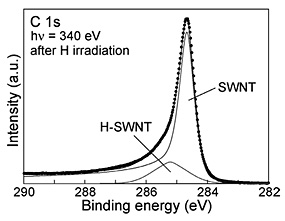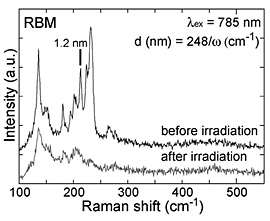1Materials Science Laboratory
2Synchrotron Radiation Research Center, Japan Atomic Energy Agency
3Department of Physics, Tokyo University of Science and CREST-JST
4Japan Synchrotron Radiation Research Institute
Single-walled carbon nanotubes (SWNTs) are of great interest as a promising
material for a new generation of electronics. Controlling their properties
is an impotant challenge. Bacause the properties deeply depend on the SWNT
structure, surface modification is suitable for such control. Additionally,
selecting reactions in SWNTs is attractive as a way to extract nanotubes
having desirable properties. It has been predicted theoretically that C-H
bonds are stable for small-diameter SWNTs [1], and that the band-gap modulation
depends on the coverage of hydrogen [2]. In this work, we investigated
the adsorption of atomic hydrogen on SWNTs with the aim of controlling
SWNT properties through surface modification.
In situ core level photoelectron spectroscopy (PES) was used for the chemical
analysis, and ex situ Raman spectroscopy was used for the structural deformation analysis. By
fitting the C1s core level spectrum captured after atomic hydrogen irradiation, we found
the C-H bonds in the nanotubes as shown in Fig. 1. Before and after PES
measurement, Raman spectra were captured as shown in Fig. 2. The spectra
demonstrate that, by the irradiation, the radial-breathing-mode (RBM) intensity
of small-diameter SWNTs (less than about 1.2 nm in this work) is severely
decreased compared to that of large-diameter SWNTs. Raman spectroscopy
results indicate adsorption-induced bonding-structure deformation is generated
more easily on small-diameter SWNTs. Taken together, these results indicate
that hydrogen atoms adsorb more preferentially on SWNTs with small diameters
[3]. Our results suggest that SWNT properties can be modified selectively
by controlling hydrogen adsorption.
[1] T. Yildirim et al., Phys. Rev. B 64 (2001) 075404.
[2] K. A. Park et al., J. Phys. Chem. B 109 (2005) 8967.
[3] A. Tokura et al., Carbon 46 (2008) 1903.
 |
 |
|||||
|
|